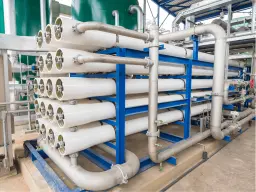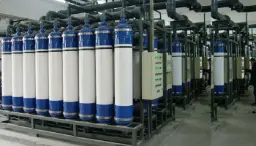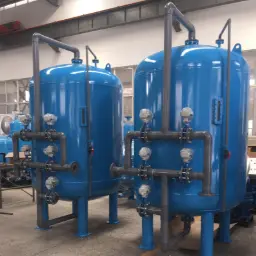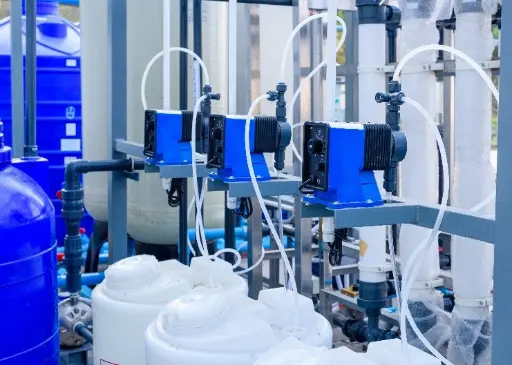Steam Condensate Recovery for Textile Industry
Steam condensate recovery and reuse intersects thermal engineering, chemical conditioning, and resource management in a single, highly integrated loop. Textile mills generate large volumes of low-pressure steam for dyeing, washing, drying, and calendaring. As that steam condenses inside heat exchangers and production equipment, it retains around 15 % of the energy that was originally injected into the boiler feed water. Returning this hot, treated condensate to the boiler house instead of discharging it conserves fuel, reduces make-up water demand, and stabilises boiler chemistry. Yet the pathway from point-of-use back to the deaerator is complex: it traverses kilometres of stainless or carbon-steel piping, passes through flash separators, and encounters numerous contamination risks from process leaks, lubricants, dye bath additives, and corrosion by-products. Each potential contaminant threatens boiler integrity by introducing dissolved solids, oils, or oxygen that can trigger scaling, foaming, or pitting. Consequently, a dedicated water-treatment strategy tailored to textile operations is essential.
From an operational viewpoint, effective condensate recovery begins with accurate mapping of steam headers, trap stations, and flash tanks, followed by the installation of sensors that track flow, temperature, and conductivity in real time. Digital twins that model condensate temperature profiles across different fabric lines help predict flashing losses, while variable-frequency return pumps minimise hydraulic surges during sudden load changes. Sustainability goals reinforce the practice: every tonne of condensate that is recycled avoids roughly 0.95 tonnes of CO₂ emissions linked to additional steam generation. It also lessens wastewater loading in on-site effluent treatment plants, which often struggle with high salinity and colour species inherent to textile dye houses. Together, those drivers have elevated condensate recovery from a cost-saving measure to a strategic pillar of environmental, social, and governance (ESG) reporting across global textile supply chains.
Related Products for Boiler Feed Water Treatment

Reverse Osmosis
Treats incoming raw water so that any make-up added to the condensate loop meets strict silica and alkalinity limits, thereby mitigating carry-over and scaling.

Ultrafiltration
Removes suspended solids and colloids as a pretreatment step, enhancing downstream performance.

Deionization
Removes trace iron, copper, and hardness ions picked up in distribution lines, safeguarding high-pressure boiler tubes from deposition and under-deposit corrosion.

Dosing Systems
Integrates pH adjustment, neutralising amine injection, and film-forming agents with online ORP and conductivity probes to maintain boiler chemistry within narrow control bands.
These systems create a layered defence that prevents contaminants from entering the boiler while recovering maximum sensible and latent heat. By combining mechanical separation, advanced membrane technology, and precision chemical control, the textile mill achieves both reliability and energy efficiency. Integration with a plant-wide SCADA platform further enhances performance by correlating condensate purity with steam trap maintenance records and production schedules, allowing proactive interventions before deviations escalate into costly shutdowns.
Key Water-Quality Parameters Monitored
Condensate returning from diverse textile processes is deceptively clear, yet its chemical fingerprint can change abruptly when a valve sticks, a heat exchanger plate leaks, or steam traps fail in the open position. That volatility demands continuous monitoring of multiple water-quality parameters so operators can isolate and correct issues before they escalate into boiler excursions. Conductivity offers an immediate, aggregate indication of ionic contamination; sudden spikes above baseline often signal a dye bath breach or raw water dilution. pH, although somewhat buffered by neutralising amines, warns of acid ingress that could accelerate corrosion rates in feed-water lines. Total Organic Carbon (TOC) provides early detection of oils, sizing agents, or surfactants that might generate foam within boiler drums, while dissolved oxygen must stay near the detection limit to avoid pitting on high-stress areas such as tube-sheet welds.
Silica, though naturally present in many feed-water sources, becomes particularly troublesome in high-pressure boilers above 30 bar where it volatilises and deposits on turbine blades used for cogeneration. Iron and copper, released from corroding condensate lines, can co-deposit with phosphates, hindering heat transfer and fostering under-deposit corrosion. Turbidity, albeit low in well-maintained loops, still merits attention because suspended fibres or rust particles act as nuclei for scale formation. Finally, microbiological activity—especially acid-producing bacteria—can occur in intermittently used lines or poorly drained low points, necessitating occasional biocide rinses.
| Parameter | Typical Range | Control Method |
|---|---|---|
| Conductivity | < 30 µS cm⁻¹ | Continuous inline cell, bleed-and-feed control |
| pH | 8.3 – 9.2 | Neutralising amine dosing via PID pump |
| Dissolved Oxygen | < 10 µg L⁻¹ | Degasification membrane, hydrazine/DEHA scavenger |
| Silica | < 20 µg L⁻¹ | Reverse-osmosis make-up, mixed-bed polisher |
| Iron (Total) | < 50 µg L⁻¹ | Condensate polisher resin regeneration |
| TOC | < 0.5 mg L⁻¹ | Cartridge oil filters, periodic surfactant flush |
| Turbidity | < 0.2 NTU | 5 µm pre-filters, ultrasonic flow balancing |
Design & Implementation Considerations
Engineering a condensate recovery system for a textile mill begins with a detailed mass- and energy-balance that accounts for steam generation rates, fabric line demands, and seasonal variability such as yarn pre-heating in winter. Pipe sizing uses Darcy-Weisbach calculations adjusted for two-phase flow to minimise velocity-induced erosion while preventing condensate stagnation during partial load. Material selection often favours 304 L stainless steel for main headers to resist acidic attack, while schedule-80 carbon-steel suffices for low-temperature return lines where oxygen levels are minimal. Designers position flash tanks at strategic elevation differences to utilise gravitational separation and avoid costly vent losses. Control valves with equal-percentage trim handle large turndown ratios, ensuring stable back-pressure regardless of batch process fluctuations typical in dye houses.
Automation philosophy follows ISA-88 batch principles layered onto a plant-wide ISA-95 hierarchy. Programmable logic controllers collect conductivity, level, and pressure signals, feeding them into a distributed control system that orchestrates degasifier vacuum pump speed and polisher regeneration cycles. Smart traps equipped with Bluetooth-enabled temperature probes send real-time performance data to a central dashboard, allowing maintenance teams to target high-leakage areas first. International codes such as ASME Section I govern boiler external piping, while ISO 22000 hygiene guidelines influence chemical selection where condensate might contact food-grade viscose fibres. NSF/ANSI 5 listings guide choice of stainless-steel fittings in installations where recycled condensate indirectly heats potable water. Emerging digital twins integrate Computational Fluid Dynamics to visualise condensate flash kinetics, enabling virtual commissioning long before shut-down windows open.
Operation & Maintenance
Sustaining high condensate return rates hinges on disciplined preventive maintenance that aligns with textile production cycles. Daily operator rounds verify that deaerator vent rates stay within design limits, typically 0.1 % of steam flow, confirming efficient oxygen removal. Conductivity alarms above 30 µS cm⁻¹ trigger immediate grab-sample cross-checks and dye-house inspections to locate possible heat-exchanger leaks. Cartridge oil filters run on a differential-pressure regime; elements are swapped when pressure drop exceeds 0.7 bar to avoid bypass valve opening. Ion-exchange polishers follow counter-current regeneration with 5 % caustic and 10 % acid sequences, extending resin life beyond 40,000 bed-volumes.
Quarterly Clean-in-Place (CIP) procedures alternate between alkaline and acidic formulations to dissolve organic films and metallic scales respectively. Membrane degasifiers receive a low-pH sanitising flush every six months to inhibit biofilm development on hydrophobic pores. Spare-parts strategy centres on critical spares such as conductivity transmitters, vacuum pumps, and modulating control valves; each is stocked in duplicate to meet a two-hour maximum mean time to repair (MTTR). Competency matrices for operators include advanced modules on steam-trap thermodynamics, ensuring they can interpret ultrasonic trap-testing data without relying solely on external service providers. Cloud-based CMMS platforms schedule work orders and link vibration-analysis trends for pumps with corresponding energy savings, closing the loop between maintenance actions and sustainability metrics.
-
Key Maintenance Tasks after Initial 15-Sentence Overview:
- Weekly trap blow-through inspections using ultrasonic probes
- Monthly polisher water-sample analysis for sodium leakage
- Bi-monthly integrity testing of membrane degasifier modules
- Semi-annual recalibration of inline TOC analysers
- Annual stress-corrosion inspection using phased-array ultrasonics
Challenges & Solutions
Despite meticulous design, real-world condensate systems face persistent challenges that stem from both process variability and human factors. Textile mills frequently change dye recipes, introducing surfactants that can break oil-removal filter surface tension, passing organics forward. Intermittent production schedules allow condensate to cool below 60 °C, an ideal range for oxygen ingress and microbial growth. Regulatory bodies such as local environmental agencies tighten discharge limits on colour and COD, increasing pressure to maximise internal reuse. Mechanical components like steam traps show wear patterns accelerated by lint accumulation—a by-product unique to textile environments—not accounted for in generic trap-life predictions. Digital transformation initiatives often stall at the pilot stage when IT departments raise cybersecurity concerns about connecting legacy boilers to cloud analytics.
-
Common Issues and Mitigation Steps after Introductory Text:
- Scaling from Hardness Break-Through: Implement conductivity-based polisher regeneration algorithms to prevent ionic slippage.
- Bio-Fouling in Idle Lines: Schedule thermal shock rinses at 95 °C during weekend shutdowns and dose a biodegradable biocide compatible with dye processes.
- Regulatory Hurdles on Discharge Temperature: Install plate heat-exchangers to recover residual heat for pre-heating process baths, cooling condensate below 40 °C before any potential blow-down.
Advantages & Disadvantages
Adopting Steam Condensate Recovery for Textile Industry water treatment delivers clear economic and ecological upsides, yet it is not without constraints. Captured heat energy reduces natural-gas or coal consumption by up to 20 %, shrinking the carbon footprint at a time when brands impose strict Scope 1 emission caps on suppliers. Lower make-up water intake translates to smaller demineralisation units, cutting capital expenditure and chemical consumption. Improved boiler feed-water quality stabilises drum levels and minimises carry-over, thereby enhancing product quality through consistent fabric moisture profiles. However, initial retrofit costs can be high where legacy plants require wholesale pipe replacement to achieve the necessary fall gradients for gravity return. Maintenance complexity rises because additional polishers and sensors demand specialised knowledge, and any contamination event, although rarer, has higher consequence due to the larger boiler capacity often installed alongside high condensate recovery targets.
| Pros | Cons |
|---|---|
| 15 – 20 % fuel savings through heat recovery | High upfront capital for flash tanks and polishers |
| Reduced make-up water and chemical demand | Increased maintenance skill requirements |
| Lower greenhouse-gas emissions, aiding ESG scores | Potential downtime during retrofit integration |
| Enhanced boiler life via cleaner feed-water | Space constraints in crowded utility areas |
| Compliance with stricter wastewater regulations | Risk of rapid system-wide contamination if leaks occur |
Frequently Asked Questions
Textile professionals routinely raise nuanced questions when evaluating condensate-recovery projects. Many wonder whether high concentrations of dyes or finishing agents can volatilise and enter the boiler, despite evidence that most large-molecule organics remain in the liquid phase. Others ask about the payback period, which in medium-sized mills averaging 20 t h⁻¹ of steam typically ranges from 12 to 24 months, depending on fuel price volatility. Safety is another recurring concern: returning condensate at 100 °C poses scalding risks during maintenance, so plants must deploy double-block-and-bleed isolation and clearly marked hot-surface signage. Operators also enquire about the fate of neutralising amines in finished textiles; industry studies confirm that amine residuals volatilise during drying and do not accumulate in fibre matrices. Financial controllers frequently request clarity on whether carbon-credit schemes recognise condensate-recovery energy savings—verification methodologies under ISO 14064 do, provided robust measurement and verification protocols are in place.
Q1: What percentage of condensate return is realistic for a modern textile mill?
A1: Well-designed systems routinely achieve 80 – 90 %, provided that steam traps are well maintained and high-temperature contaminants are controlled.
Q2: Can dye bath chemicals enter the boiler via condensate?
A2: Trace carry-over is possible if heat-exchanger gaskets fail; installing conductivity alarms and oil-removal filters prevents most excursions.
Q3: How long does resin in a condensate polisher last?
A3: With counter-current regeneration and low-iron feed, mixed-bed resin can operate effectively for three to five years before re-bed is needed.
Q4: Do membrane degasifiers eliminate the need for chemical oxygen scavengers?
A4: They reduce dosage significantly, but a small residual scavenger feed is advisable to handle ingress during maintenance or power outages.
Q5: What standards apply to condensate piping in food-grade textile production?
A5: ASME B31.1 covers power piping, while ISO 22000 hygiene principles guide material and chemical selection in processes touching food-contact fibres.
Q6: Is condensate recovery compatible with biomass-fired boilers?
A6: Yes; in fact, the higher ash potential in biomass systems makes clean condensate even more critical to minimise carry-over fouling.
Q7: How does digitalisation improve condensate-system reliability?
A7: Real-time analytics detect anomalies within seconds, enabling predictive maintenance of traps and pumps before energy losses escalate.